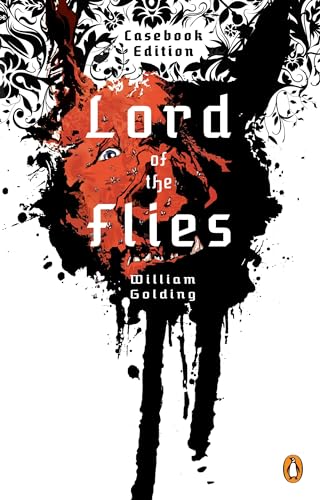The Lord of the Flies: Complete Edition with Text, Notes, and Criticism
William Golding’s iconic novel, Lord of the Flies, is a gripping and disturbing exploration of human nature and the darkest aspects of civilization. Set on a deserted island, the novel follows a group of British boys who must navigate the challenges of survival and leadership after being stranded without adult supervision. As their society descends into chaos and violence, Golding exposes the fragility of order and the inherent evil that lurks within us all. With its powerful themes and timeless relevance, Lord of the Flies continues to captivate readers and spark important discussions about morality, power, and the nature of humanity.

Goldingʼs Lord of the Flies Plot Summary
In William Golding’s novel, “Lord of the Flies,” a group of British boys find themselves stranded on a deserted island after their plane crashes. The boys, ranging in age from six to twelve, must fend for themselves and figure out a way to survive until they are rescued.
The story begins with a group of boys emerging from the wreckage of the plane and coming together on the beach. Ralph, a natural leader, is quickly elected as the group’s chief. He is joined by Piggy, a bookish and insecure boy who quickly becomes Ralph’s closest companion. Together, they attempt to organize the other boys and establish a system of rules and order on the island.
However, they soon encounter Jack, a manipulative and power-hungry boy who leads the choirboys. Jack is determined to challenge Ralph’s leadership and establishes his own tribe, hunting pigs and indulging in savagery. As Jack’s tribe becomes more brutal and violent, the boys’ civilized society begins to disintegrate.
The group is further divided when Simon, a gentle and introspective boy, discovers that the “beast” they fear is actually a dead parachutist tangled in the trees. He tries to share this information with the others, but is mistaken for the beast and killed in a frenzied hunt.
As tensions rise between Ralph and Jack, the boys find themselves descending into chaos and violence. The once orderly society breaks down completely as Jack’s tribe begins to hunt Ralph and Piggy. In a final confrontation, Piggy is killed and Ralph is left alone to fend for himself. Just as he is on the brink of being killed by Jack’s tribe, a British naval officer arrives on the island and rescues the boys.
The novel ends with Ralph weeping for the loss of innocence and the brutality that consumed the once peaceful island. Golding’s “Lord of the Flies” serves as a powerful allegory for the inherent evil that exists within all human beings. The boys’ descent into savagery reflects the darkness that lies beneath the thin veneer of civilization and the fragile nature of societal order.
Throughout the novel, Golding explores themes of power, authority, human nature, and the destructive potential of unchecked aggression. The boys’ struggle for survival becomes a microcosm of society at large, highlighting the thin line between civilization and barbarism.
Overall, “Lord of the Flies” is a thought-provoking and haunting tale that forces readers to confront the darker aspects of human behavior and the consequences of unchecked power. Golding’s exploration of these themes continues to resonate with readers today, making the novel a timeless and enduring classic.
Goldingʼs Lord of the Flies Key Takeaway
One key takeaway from Golding’s Lord of the Flies is the idea that human nature has a dark side that can manifest itself in the absence of civilization and order. The novel portrays a group of British boys stranded on a deserted island, who initially attempt to maintain order and rules, but gradually descend into chaos and violence as their primal instincts take over.
Through the character of Jack, Golding shows how power and the desire for dominance can corrupt even the most seemingly innocent individuals. Jack’s descent into savagery as he becomes obsessed with hunting and violence mirrors the breakdown of societal norms and the loss of morality that occurs when the constraints of civilization are removed.
Additionally, the novel explores the idea of the inherent evil within all humans, as symbolized by the character of the “beast” that the boys fear. This beast is not a physical entity, but rather a manifestation of the darkness that lies within each of them, waiting to be unleashed when faced with fear and uncertainty.
Overall, Lord of the Flies serves as a powerful cautionary tale about the fragility of civilization and the potential for chaos and brutality that lurks within us all. It reminds us of the importance of moral codes and societal structures in keeping our darker impulses in check, and the consequences of allowing them to run unchecked.
Conclusion
In the final chapters of Golding’s “Lord of the Flies,” the civilized society established by the boys on the island collapses into chaos and violence. The boys, once innocent and hopeful, become savage and bloodthirsty, mirroring the darkness that exists within all of humanity. The story culminates in a tragic and violent confrontation between the two factions of boys, ultimately leading to the rescue of the survivors by a passing naval officer.
The novel is a powerful exploration of the darker aspects of human nature, exposing the inherent savagery that lies beneath the surface of civilization. Golding skillfully delves into themes of power, control, and the loss of innocence, creating a chilling and thought-provoking narrative that forces readers to confront uncomfortable truths about themselves and society.
I recommend “Lord of the Flies” to readers who enjoy compelling and thought-provoking literature that explores the complexities of human nature. Those who appreciate allegorical storytelling and themes of morality and ethics will find much to ponder in Golding’s work. This novel is a haunting and gripping read that is sure to leave a lasting impact on those who dive into its dark depths.

No responses yet